|
Getting your Trinity Audio player ready...
|
Reading Time 10 mins
December 21, 2023
‘Perhaps the most extensive injustice is that the indigenous people of the region, who have experienced genocide and have otherwise been historically marginalized, have not been considered in these decisions. Neither are the issues of exploitation and rape of the indigenous people of the Essequibo region, cross-border crime, migration issues, and the environmental threat to an area that is regarded as one of the best-preserved parts of the Amazon biome.’
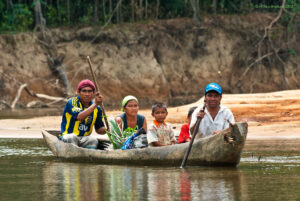
An indigenous family paddled down the upper Rupununi River in their dugout canoe. The Rupununi River is a major tributary of the Essequibo.
In his infamous Star Wars speech on March 10, 1983, former U.S. President Ronald Reagan declared in no uncertain terms that his administration was bent on reversing the Grenada Revolution. But Reagan reminded us that “It [wasn’t] nutmeg [that was] at stake in the Caribbean and Central America; [it was] United States’ national security.” The United States invaded Grenada merely nine months later in an operation accordingly dubbed “Urgent Fury.”
A deadly monster is again lurking beneath the calm waters of the Caribbean/Latin American region. This creature is not one of our jab jab characters. It is the ugly, oily, crude face of empire. It is spurring the contest between the forces that regard the Caribbean as a Zone of Peace and development and that of wars of conquest. We have seen this script before.
Supposed U.S. interest, enshrined in and given pseudo-philosophical rationale with the Monroe Doctrine of 1823, has been used by successive U.S. administrations to assume a divine right to be ‘guardians’ of the Caribbean and Latin American shores and boundaries. According to this warped logic, the region’s bountiful resources and oil reserves are perceived to be within the scope of the U.S. national interest. Venezuela’s colossal oil reserves and recent discoveries in neighboring Guyana and Suriname coalesce to compound and relegate the region to this self-described ‘zone of American national security interests.’
However, the legacy of colonialism in the region remains a geo-political fault line. It can be stroked for explosion and a pretext for intervention, as has been the case repeatedly for centuries in various areas of the Americas. This danger is not hard to appreciate.
What is now the Cooperative Republic of Guyana became a British colony after the Napoleonic Wars1. The new British colony’s western boundary was unclear and largely unsettled, especially where it meets newly independent Venezuela.
Active extraction of Guyana’s oil by multinational corporations (primarily US-based) has reinvigorated the Bolivarian Republic of Venezuela’s long-standing irredentist claims to the Essequibo region. Venezuela’s petition encompasses two-thirds of Guyana’s territory and is an area greater than England. Venezuela had considered Essequibo its territory since its independence from Spain in 1811.
The current Venezuelan national flag was modified in 2006 and introduced by the then government of Venezuela’s president, Hugo Chávez, for expansionist reasons. The new flag, opposed by much of the present country’s opposition for different reasons, added an eighth star representing the Guayana Province. It would join the original seven Provinces of Venezuela that were signatories to its declaration of independence. What Venezuela considers its Guayana province represents two-thirds of what is now the Cooperative Republic of Guyana. It is within the Exclusive Economic Zone where much of the present Guyanese oil extraction occurs.
On December 3, Venezuela went further by holding a referendum on its Essequibo claim, albeit without the involvement of the Essequibo inhabitants. Following the referendum, Venezuela declared its will to establish a state incorporating the Essequibo region, among other measures, to effect its reclamation. Voters in the referendum, in effect, rejected the International Court of Justice’s (ICJ) jurisdiction over the area and agreed to the creation of a new Venezuelan state, “Guyana Esequiba” province.
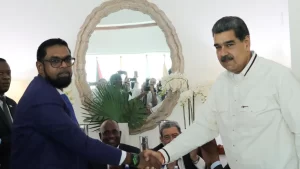
Venezuela’s President Nicolas Maduro and Guyanese President Irfaan Ali shake hands as they meet amid tensions over a border dispute in Kingstown, St. Vincent, and the Grenadines on December 14, 2023. © Miraflores Palace via Reuters
So when it was announced that in collaboration with the Guyana Defence Force (GDF), the U.S. Southern Command (USSOUTHCOM) is conducting flight operations within Guyana on December 7, memories of past echoes of ‘U.S. national interests’ and the apparition of James Monroe, Reagan, et al., reverberated throughout the hemisphere. The U.S. had previously hosted 21 regional countries in preparation for ground, air, sea, and cyber domains in various locations across Guyana on July 15-28. Dubbed Trade Winds 23, this is the 38th iteration of US SOUTH COM exercises across the region since the U.S. invasion of Grenada in 1983. It is ironic that in 1876, when Venezuela protested the British expansion of territories west of the Essequibo, they appealed to the United States for assistance, citing the Monroe Doctrine to justify U.S. involvement; at present, it would seem that Guyana is inviting the U.S. in the ongoing conflict to defend its territorial integrity.
Following the referendum vote, Brazil, which shares a border with Venezuela and Guyana, deployed troops to its border with Venezuela. However, the threat of war is one of several concerns. Another is the environmental risk in an area that can be considered the lungs of the planet.
With projections of nearly one million barrels of oil daily, Guyana now represents the U.S.-based Exxon Mobil Corporation’s largest single source of fossil fuel production anywhere in the world. At the same time, there are various projections on the amount of extraction to be carried out by Exxon and others. Very little attention is paid to its environmental cost and risk to the immediate area and the wider Caribbean/Latin American region. For example, Exxon’s operations in Guyana are estimated to send more than two metric tons of climate-destroying CO2 into the atmosphere.
Unlike the colonial blight of amorphous borders of the Guyanas, environmental crimes have no borders. Guyana’s oil boom, expected to make it the world’s fourth-largest offshore oil producer, raises concerns about potential oil spills and to what extent oil contributes to the climate change that already threatens to impact the country’s precarious coastal areas.
Moreover, as part of its extractive production, Exxon flares or burns its excess gas. This only adds to already existing risky extractive activities in the sub-region. In its first year and a half of production in the Guyana operations alone, the flaring from burning excess gas contributed nearly 770,000 metric tons of greenhouse gas emissions to the area – the equivalent of driving 167,000 cars for one year. Anette Ajoon, an Amerindian marine conservationist who is active in the Essequibo region, sees the mixed blessing of the oil boom and believes that Exxon is indifferent to the dangers of an oil spill to the coast and rivers of the pristine regions and is deceptive, declaring the corporation’s behavior “thuggish and disrespectful.” She noted the risk of endangering the rich rainforests that cover 80% of Guyana, which made it a carbon sink absorbing far more of the planet-heating greenhouse gas than it emits.
Beyond the environmental danger, the Essequibo border conflict, amplified by the allure of the sub-region’s extractive resources, is worsening social relations, renewing great power calculations, and threatening peace and security in the Caribbean/Latin American region. It adds to existing national tensions, invokes colonial ghosts, and casts a long shadow over the Caribbean’s aspirations for peaceful co-existence and sustainable development.
As echoed by Caribbean leaders Cheddi Jagan, Maurice Bishop, Hugo Chavez, and others, the best interest and desire of the Caribbean people is to live in a zone of peace and not become pawns of hegemonistic struggles. In expressing his nation’s willingness to assist in negotiations for a diplomatic resolution, Brazil’s President Luiz Inácio Lula da Silva said, “We don’t need conflict. We need to build peace.”
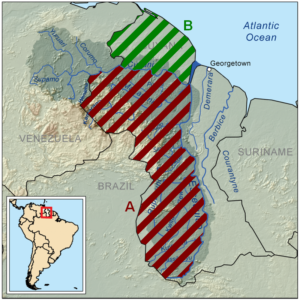
In red: comprising the Guyanese territory between the Essequibo and Cuyuni rivers. In green: comprising the Guyanese territory between the Cuyuni River and the Atlantic Ocean. Venezuela claims both areas. The picture was taken from Wikipedia under Creative Commons license CC BY-SA 3.0
With instrumental support and urging of Brazil’s Lula, regional leaders met on December 14 in St. Vincent and the Grenadines (SVG) under the auspices of the two foremost regional blocks, the Community of Latin American and Caribbean States (CELAC) and Caribbean Community (CARICOM). SVG Prime Minister Ralph Gonsalves serves as chairperson of CELAC, and the Commonwealth of Dominica’s Prime Minister Roosevelt Skerrit is now CARICOM chair. The peace talks ended in a Joint Declaration of Argyle for Dialogue and Peace between Guyana and Venezuela. Among other resolutions, the declaration obligated both sides to agree that they “will not threaten or use force against one another in any circumstances.”
Unfortunately, absent from the discussion and much of the consideration is the voice and interest of the indigenous peoples of the Essequibo region itself, whom the international decision-makers have historically relegated to spectators. The Indigenous Peoples of the area maintain that Essequibo is, and has always been, their territory even before the European colonizers invaded the continent. These territories were stolen from the indigenous people of the region through the “Papal Bull” (1493) and Treaty of Tordesillas (1494), both of which were ignored by the British, French, and Dutch in subsequent centuries to justify their incursion into the region.
The area should be respected as an Amerindian cultural heritage site since their ancestors were buried there centuries before colonialism. Petroglyphs dating beyond the Columbian era attest to this reality. Several indigenous groups call the Essequibo region home and have trans-border relations. The Essequibo area is home to 125,000 of Guyana’s 800,000 people.
Like the African continent following colonialism and the Berlin Conference((The Berlin Conference can be best understood as the formalization of the Scramble for Africa. This British coined the term sometime in 1884, and it has since been used to describe the twenty-plus years when the various European powers explored, divided, conquered, and began to exploit virtually the entire African continent – https://www.sahistory.org.za/article/berlin-conference)), many live on different sides of the now international borders of Venezuela, Guyana, and Brazil. The African Union, the successor to the Organization of African Unity, upheld the principle of inviolability of the continent’s borders in the interest of peace and development.((https://repository.law.umich.edu/cgi/viewcontent.cgi?params=/context/mjil/article/1522/&path_info= )).
The escalating presence of the U.S. military, its Southern Command, military exercises, etc., is only the other side of the coin of Venezuela’s military build-up. Both engage in dangerous saber-rattling and push toward military conflict rather than a win-win negotiated resolution. The U.S. must not be allowed to push this region into the kind of savage war that is going on in the Middle East right now.
Venezuela advances that its eastern border extended well beyond the Orinoco to the Essequibo River during the colonial era. However, Venezuela’s early leaders had accepted the present borders during the 19th century, having been drawn by international arbitration in the Arbitral Award of October 3, 1899.
The Venezuelans later contested the ruling, stipulating that it deprived the country of much of Essequibo, including its rich mineral stock and prized goldmines. Venezuela alleged corruption and undue pressure on the Russian arbitrator in the tripartite arbitration, which consisted of Britain, the U.S., and a Russian representative (the latter serving as a non-interested broker). The then-young and inexperienced Venezuela was not directly represented in the arbitration, with the U.S. assuming guardianship per the Monroe Doctrine.
The issue was never resolved. With Guyana approaching its independence and in an atmosphere of the Cold War (mainly British and U.S. opposition to Guyanese socialist leaders), Venezuela denounced the 1899 Arbitration by challenging the international judges’ impartiality. It declared the award “null and void.”
In an attempt to break the impasse, a 1966 Geneva Agreement committed the Republics to seek a peaceful solution through direct dialogue. One of the stipulations of the Geneva Agreement is that such negotiations would arrive at a practical and satisfactory solution for both sides of the conflict. It is doubtful that a practical and satisfactory solution would result in Guyana agreeing to surrender two-thirds of its territory that is enshrined in its constitution and has governed since independence. Doubtful is the expectation that Venezuela, with strong historical ties to the region, would be deprived of any economic or political relationship with that region.
One wonders if a viable solution might be for regional Amerindians, Venezuela, and Guyana to share the resources of the disputed territory through some tri-lateral arrangement or joint venture in which each entity shares ownership of the vast resources of that sub-region.
A sub-region of the Americas, an area that was the first colonial scramble for territories, the Guyana-Venezuela contest over Essequibo is a present-day legacy of typical hegemonic musical chairs. This has been played out throughout the Caribbean archipelago and across the length and breadth of the Latin American region for centuries.
Perhaps the most extensive injustice is that the historically marginalized indigenous people of the region have experienced genocide and been ignored by colonial and contemporary decision-makers for centuries. Neither are the issues of exploitation and rape of the indigenous people of the Essequibo region, cross-border crime, migration issues, and the environmental threat to an area that is regarded as one of the best-preserved parts of the Amazon biome. More sustainable than oil, the region possesses tremendous endemic wealth and is an essential global environmental stock.
The territorial controversy between Guyana and Venezuela is not merely a border quarrel. It is a crossroads where the future of the Caribbean and Latin American region hangs in the balance. The people of the Caribbean/Latin American region have expressed wishes to choose peace over conflict, development and environmental health over dispossession and exploitation, and regional cooperation over external manipulation.
Let the Caribbean waves lap against peaceful shores, not the blood-stained sands of war. Let history remember this not merely as a chapter of an imperial contest but as a testament to the region’s unwavering resolve to a future of peace, prosperity, environmental justice, and self-determination.
Return to BDN’s Introduction.
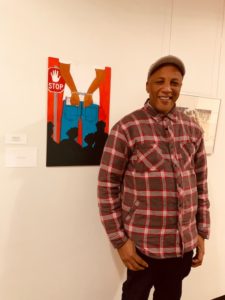 Martin P. Felix is co-editor of Big Drum Nation. A visual artist and educator, he lives with his family in New York City.
Martin P. Felix is co-editor of Big Drum Nation. A visual artist and educator, he lives with his family in New York City.
- Napoleonic Wars was a series of wars between Napoleonic France and shifting alliances of other European powers that produced a brief French hegemony over most of Europe. Guyana Essequiba was controlled by the Spanish and Dutch empires, which would later cede it to the British. Part of the area was under the Captaincy General of Venezuela, founded in 1777. It was later integrated into the nascent Republic of Venezuela in 1811. 1814 the Treaty of London was signed, ending the Napoleonic Wars. Defeated Holland was forced to cede up 20,000 sq ml of its possessions east of the Essequibo. This territorial extension includes Demerara, Berbice, and Essequibo. [↩]

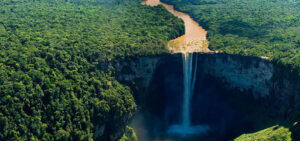
Only the genuinely collective intellectual muscle of a body of quite-hard-to-find respectable human beings unselfishly focused on the psychological , economical and especially multicultural reparations of what has come to be regarded as Caribbean/Latin American relics of notoriously greedy colonization with all its trappings of exploitation , deprivation and persistently deliberate miseducation could (and let me repeat: could) succeed in assuring this region’s desirable “Zone of Peace”.